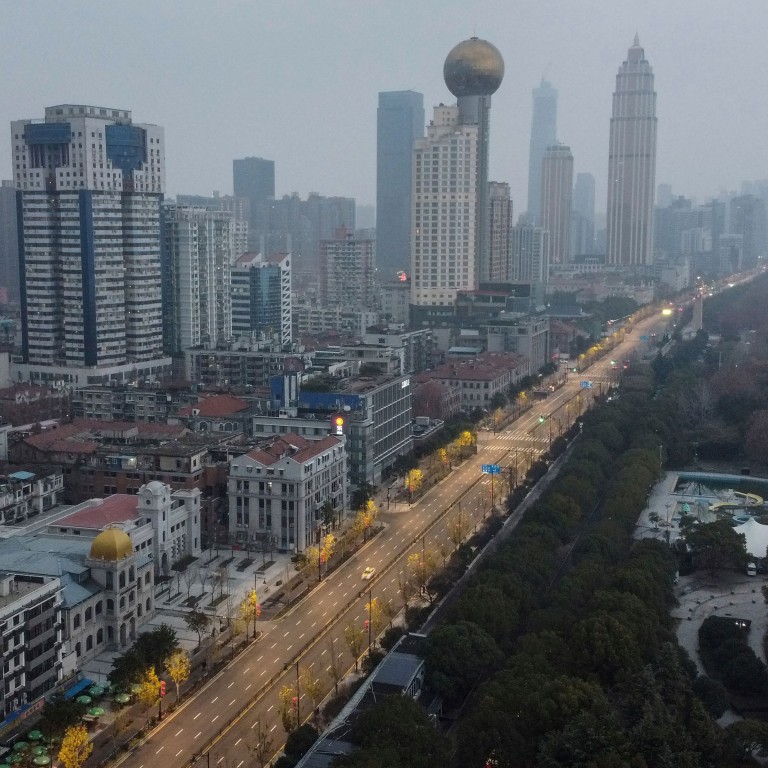
Laid low by coronavirus, Wuhan’s industrial heart is kept beating by its defence industries
- Hubei’s capital city by the Yangtze River has become synonymous with China’s fight against deadly disease
- Outbreak has been a major setback for Wuhan’s economic and social stability, but experts say its history as defence and transport hub in central China give it hope
While modern Wuhan is a key port on the Yangtze River with access to dozens of resource-rich lakes, the city has been a transport hub in central China for centuries. Today, its railways, air services and waterway systems connect nine provinces on the mainland.
The city has also played a major role in China’s turbulent history. The first shots in Sun Yat-sen’s nationalist Xinhai revolution against the ruling Qing dynasty were fired in Wuchang, one of the three districts in Wuhan, on October 10, 1911. That revolution swept aside the dynasty that had ruled since 1644 and paved the way for the Republic of China (ROC).
In the years before the 1911 revolution, Hubei had become a centre for industrialisation. Zhang Zhidong, a minister of the Qing government, advocated a policy of “controlled reform”, a movement that included military modernisation, in the late 1800s.
To train a new military, Zhang established a Western-style military academy in Hubei, introduced Germany’s renowned bolt-action Mauser rifles to its forces, and set up arsenals in Wuhan.
Railways connecting Hubei, Sichuan and Guangdong provinces were built, consolidating Wuhan’s place as a centre of a modernising China.
In 1927, Wuhan municipality was formally created when the ROC decided to merge Wuchang and Hanyang districts and Hankou town into a metropolis, making it the biggest city on the middle Yangtze River basin.
China-Japan relations show further signs of thaw amid virus support
During the second Sino-Japanese war of 1937-45, Wuhan became the headquarters of the Chinese military, when the then ruling Kuomintang leader Chiang Kai-shek and Mao Zedong’s Communist Party agreed to put their fight for power aside to oppose imperial Japan together.
Wuhan is often described by Chinese military enthusiasts as the “cradle of Chinese naval ships”, where the state-owned China Shipbuilding Industry Corporation has six naval institutes.
These are focused on research and development as well as engineering and computing facilities, all the technologies required to build warships and commercial vessels.
In 1949, when the Communist Party defeated the Kuomintang and ended a civil war that began in 1927, the People’s Liberation Army Navy set up its first higher educational institute in Wuhan – the PLA Naval University of Engineering.
Today, its lead engineer, Ma Weiming, is recognised for his role in developing an electromagnetic aircraft launch system which is expected to be used on the PLA’s next-generation aircraft carrier, as well as a quieter propulsion system for China’s nuclear submarines.
China faces back to work concerns as firms report coronavirus infections
Wuhan is not a coastal city like Dalian in northeastern Liaoning province and Shanghai, where many ships of the PLA Navy’s modern fleet were built, and its does not enjoy their status. However, in 2013, Wuhan announced its intention of becoming the next “Detroit of China”, a move that got Beijing behind its car industry.
The title originally belonged to Changchun in northeastern Jilin province, where in the early 1950s the Chinese government hoped to build a powerhouse city for the car industry.
Wuhan’s ambition to emulate the heyday of America’s Motor City will have to wait. Ratings agency S&P Global cut its 2020 forecast for Wuhan-based Dongfeng’s earnings margins. China’s second-largest carmaker has taken a break as part of Hubei’s wider lockdown, and analysts also said that Dongfeng could lose as much as 5 per cent of production depending upon how long that continues.
It was in Wuhan that the KMT build shipyards in 1934, while in 1953, the Communist Party turned the city into a construction centre that was to turn out the PLA’s conventional submarines, frigates and landing craft.
After decades of development, Wuhan is central to Chinese military shipbuilding and its ambitions to be a world sea power.
The city of 11 million is home to more than 350 research centres and industrial institutes, as well as about 1,700 hi-tech enterprises covering aerospace, satellites, rocketry and biotechnology. Wuhan’s municipal government website boasts it is “the world’s largest college town”.
While the prolonged and widespread coronavirus outbreak has been a major setback for Wuhan’s economic and social stability, experts said its military industries were strong.
Beijing-based naval analyst Li Jie said that research projects in Wuhan had not been affected by the lockdown because security was already tight.
“So far, we haven’t heard of any scientists and researchers in the military academies and institutes in Wuhan becoming infected [by the virus], because they have been well protected, and their working and living places are isolated from the public,” he said.
However, Macau-based military observer Antony Wong Dong said some officers and researchers might have returned home on Lunar New Year leave and a prolonged outbreak might need them to work from home.
“For some sensitive jobs, working from home will increase risk,” Wong said.
Purchase the China AI Report 2020 brought to you by SCMP Research and enjoy a 20% discount (original price US$400). This 60-page all new intelligence report gives you first-hand insights and analysis into the latest industry developments and intelligence about China AI. Get exclusive access to our webinars for continuous learning, and interact with China AI executives in live Q&A. Offer valid until 31 March 2020.

